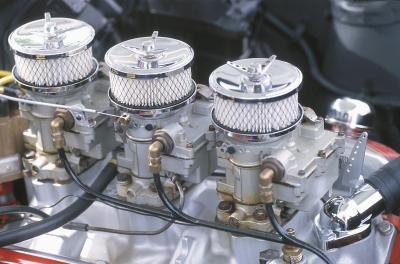Thursday, December 5, 2013
How Do Engines Burn Gas

Engines incorporate a basic but complex dance of physics, harnessing and converting energy in a multi-stage process to turn dead dinosaurs into forward velocity. The fuel molecules journey through an engine may not qualify as epic to us, but it is fairly Odyssean by subatomic standards.
Into the Engine
Fuel starts out as a liquid stored in the fuel tank. A pump shoves fuel through a line and into a filter, which gets rid of any debris that may clog the injectors. After going through the filter, fuel travels upstream to the fuel injectors. Fuel injectors work just like the spray nozzle on your garden hose, and spray out in much the same way as a garden hose nozzle on "fine mist." When you just crack the hose aperture open, pressure in the line forces water to spray out in a fine, cone-shaped mist. With an injector, this mist goes into the engine just ahead of the intake valve in multi-point fuel injected engines; on direct-injection engines, it sprays directly into the combustion chamber.
Into the Cylinder
Next, the intake valve opens and low pressures in the cylinder -- caused by a piston dropping down in the cylinder on its "intake stroke" -- suck air and fuel mist (atomized fuel) into the combustion chamber. Modern engines generally use a high-swirl cylinder-head design, which allows the air to maintain velocity and swirl like a tornado around the cylinder instead of just rushing in and slamming into a wall. This tornado effect increases power by allowing more air and fuel to fill the cylinder, and it enhances efficiency by keeping fuel suspended as a fine mist instead of allowing it to coalesce into fat droplets. This more even distribution allows more of the fuel to burn and produce power.
Boom
The intake valve closes just as the piston rises on its "compressions stroke," which (as you might guess) compresses the air and fuel into a small pocket above the piston called the combustion chamber. A spark goes off in the top of the chamber just before the piston reaches the very apex of its travel. The compressed air and fuel around the spark ignite, starting out as a tiny "flame kernel" and quickly expanding out into a bubble known as the "flame front." This bubble travels at or near the speed of sound, quickly expanding to fill the cylinder and shoving the piston back down with the force of its expanding gases and the power of its own sonic shockwave. This is the "power stroke."
The Combustion Event
Combustion is any event wherein fuel combines with oxygen to produce heat and some sort of chemical conversion. Gasoline is a hydrocarbon, meaning that its made of hydrogen and carbon atoms (commonly one carbon atom and four hydrogen atoms). When this CH4 molecule combines with O2 (oxygen gas), it produces CO2 (carbon dioxide), H20 (water) and heat. So, a pure hydrocarbon in a pure oxygen atmosphere would hypothetically produce only carbon dioxide and water. However, air is about 78 percent nitrogen by volume, and under extreme heat and pressure that nitrogen also combines with oxygen to produce dangerous nitrogen oxide emissions. Additionally, oxygen is almost always the limiting reactant in this chemical reaction, so a certain amount of fuel will leave the engine unburned during the exhaust stroke.
Combustion Malfunctions
Fuel doesnt always expand in a neat flame kernel, or front, away from the spark plug. The compressed air-fuel mixture is extremely volatile, and almost anything will set it off. This is especially true of low-octane fuels, which ignite easier than high-octane fuels. Too much heat and pressure inside the cylinder or combustion chamber will cause the fuel to auto-ignite, or "detonate." Detonation -- aka "knock or "ping" -- is extremely bad because its an explosion rather than a controlled burn, effectively identical to grilling a chicken with dynamite. These explosions happen in multiple places around the cylinder, and each one produces its own sonic shockwave. When those shockwaves collide, they instantly spike cylinder pressure and pre-ignite any remaining fuel caught between them. This kind of uncontrolled chaos is death for any engine, particularly forced-induction powerplants using a supercharger, turbo or nitrous.
No comments:
Post a Comment